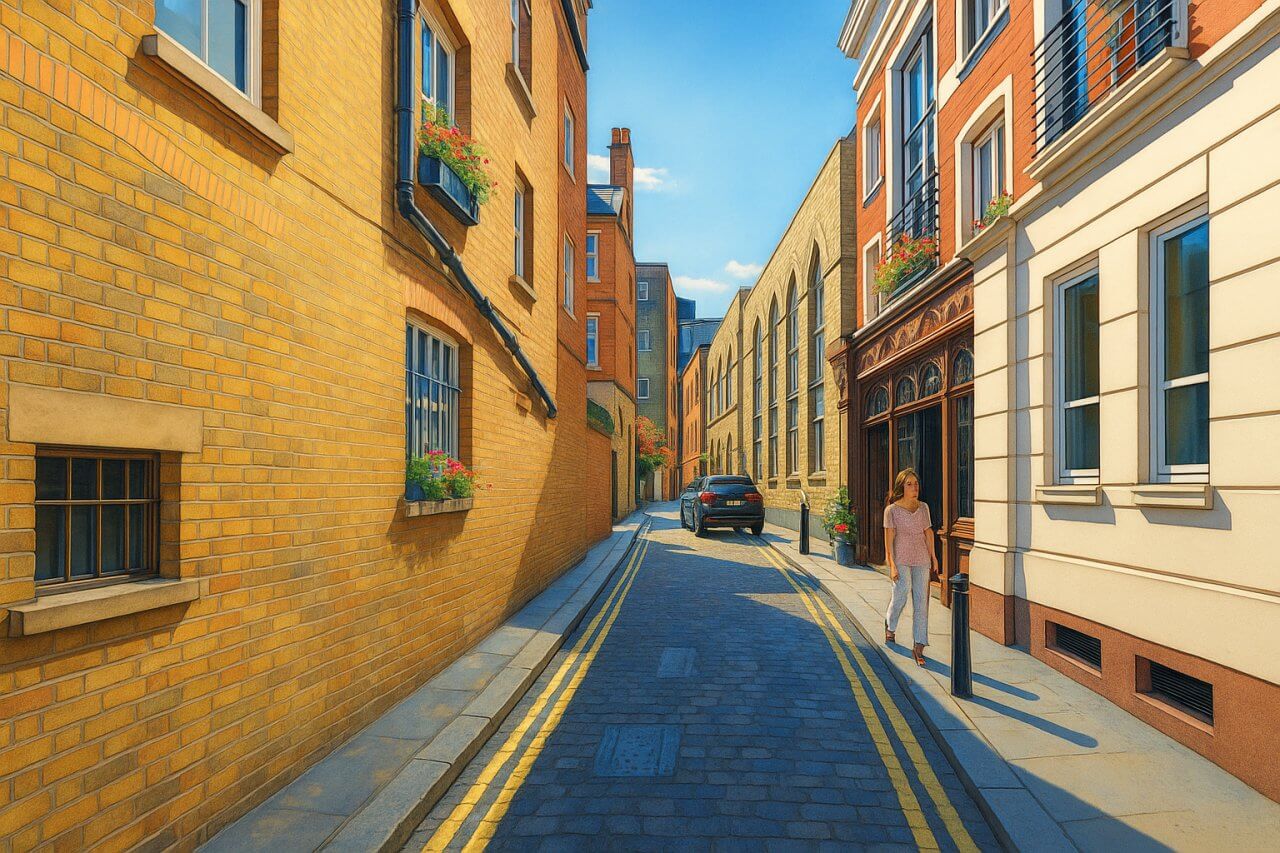
Brick Street, London
Brick Street is a short but distinctive street in Mayfair, part of the City of Westminster, central London. It forms an east–west corridor linking Old Park Lane at its western end with Piccadilly to the east. Despite its modest length, Brick Street holds considerable significance thanks to its prime location, historic associations, and architectural character.
Layout and Orientation
Brick Street is a one-way street with a unique traffic configuration: vehicles may enter from both Old Park Lane and Piccadilly, but from opposing directions. These routes converge at the central junction with Down Street, which intersects Brick Street perpendicularly.
Due to this design, Brick Street provides convenient access to Mayfair's core while also serving as a discreet thoroughfare for vehicles navigating around Hyde Park Corner and Green Park.
History and Etymology
Brick Street dates back to the early 18th century, a time when this part of Westminster was being developed into an affluent residential and commercial district. Its name reflects a straightforward derivation: it was likely named for the brick kilns or brickworks once operating in the vicinity during the late 1600s and early 1700s. Such kilns were instrumental in supplying materials for Mayfair’s expansion during this era.
The street was fully formed by the early 1800s and has evolved from a modest service street to a prestigious address. Throughout the 20th century, various townhouses and offices have occupied this stretch, contributing to its quiet yet upscale atmosphere.
Neighbouring Streets and Connections
Brick Street's immediate connections include:
- Old Park Lane to the west, which leads toward Hyde Park Corner and Park Lane
- Piccadilly to the east, one of London's grandest roads, linking Green Park and Piccadilly Circus
- Down Street, intersecting Brick Street, and providing a historical route northwards into deeper Mayfair
The location also places Brick Street near Shepherd Market, a charming enclave of restaurants, pubs, and boutiques hidden between Curzon Street and Piccadilly.
Character and Architecture
The character of Brick Street is marked by a blend of discreet affluence, traditional architecture, and contemporary redevelopment. Several of the buildings are Georgian or early Victorian in style, though modern renovations have added luxury finishes. A recent development trend has been to convert office buildings into high-end residential units, often with private concierge services and underground parking.
This combination of heritage and modern luxury makes Brick Street especially appealing to wealthy buyers seeking privacy in the heart of Westminster.
Property Market and Real Estate
As of 2025, real estate on Brick Street commands some of the highest prices in central London. A refurbished two-bedroom flat measuring approximately 1,200 sq ft (about 111 sq metres) can sell for £3.5 million to £4.2 million, depending on finishes and amenities. Rental rates hover around £8,000 to £12,000 per month for similar units. These figures reflect a premium compared to London averages, placing Brick Street firmly in the super-prime property category.
Transport Links
Nearest London Underground Stations
Brick Street is very well served by nearby London Underground stations. The closest are:
- Green Park Station – served by the Jubilee Line, Piccadilly Line, and Victoria Line (approx. 5 minutes’ walk)
- Hyde Park Corner Station – served by the Piccadilly Line (approx. 7 minutes’ walk)
These stations connect Brick Street directly to major destinations such as Heathrow Airport, King's Cross St Pancras, and Westminster via the Circle Line interchange options.
Nearby Bus Stops
Several bus stops lie along Piccadilly and Park Lane, just steps from Brick Street. Routes include:
- Bus 9 – to Aldwych and Hammersmith
- Bus 14 – to Tottenham Court Road and Putney Heath
- Bus 19 – to Battersea and Finsbury Park
These services offer frequent connections across central and west London.
Points of Interest Nearby
Within a five-minute walk of Brick Street are several notable attractions:
- Green Park – One of London’s Royal Parks, perfect for walking or picnicking
- The Ritz London – A historic and luxurious hotel at the corner of Piccadilly
- Apsley House – Home of the Duke of Wellington, known as "Number 1 London"
- Hard Rock Cafe – A classic American dining venue with rock memorabilia, located on Old Park Lane
Fun Fact
At the corner of Brick Street and Down Street once stood the entrance to a secret wartime bunker used by Prime Minister Winston Churchill before the Cabinet War Rooms were fully operational. Though now sealed, its remnants are still visible in the surrounding architecture.
Quick Facts
- Location: Brick Street, Mayfair, City of Westminster, London
- Orientation: Runs from Old Park Lane (west) to Piccadilly (east); intersects with Down Street
- Street Type: One-way with traffic entering from both ends in opposing directions
- Nearby Areas: Hyde Park, Green Park, Shepherd Market
- Historical Origin: Established in the 18th century; named after local brickworks
- Character: Quiet, upscale, with historic and modern luxury buildings
- Nearby Sights: The Ritz, Green Park, Apsley House, Hard Rock Cafe
- Underground Access: Green Park Station (Jubilee, Piccadilly, Victoria), Hyde Park Corner (Piccadilly)
- Bus Routes: 9, 14, 19 via Piccadilly and Park Lane
- Property Values (2025): £3.5–£4.2 million for ~1,200 sq ft (111 sq m) flats
- Fun Fact: Once home to a hidden wartime bunker used by Churchill
Map of Brick Street, London
 Painting of Brick Street, London
Painting of Brick Street, London